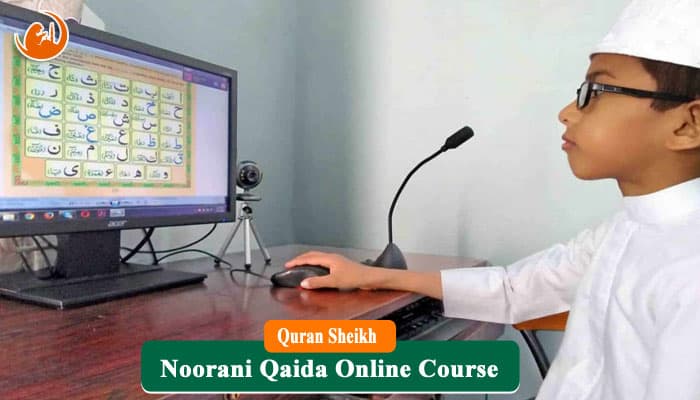Noorani Qaida Course, Learn Quranic Arabic online 30% OFF

Noorani Qaida Course: Do you like learning Quran but you can not read Arabic alphabet yet? Then this is the perfect course for you. Its never too late to start learning to read the Quran with Arab Teachers! Sign Up Now.
Get 30% OFF now
Can’t Drive Your Kids To The Mosque?
They can learn online via Zoom, Noorani Qaida course will help them in pronunciation of the Arabic alphabet then slowly move to joining letters to make words.
They will learn:
By the end of this course they will be able to look directly into the Quran and read it well In Sha Allah.
Learn Quran Online with Arab Teachers
COURSE STRUCTURE:
Class Type: One-On-One
Age: 5 up to 85
No. of Levels: 17 Levels
For: Beginners (Kids & Adults)
It’s excellent , It’s five stars 🌟🌟🌟🌟🌟
Also the teacher Yacob very kind the teaching is excellent, we’re happy, May Allah will give ajeer inshallah, Ameen.

London, UK
For me every thing is excellent. Mash Allah and Alhamdulillah. May Allah grant sheikh Hassan success. Ameen

London, UK
My teacher is the best. AlHamdulillah, Jazaka Allah Kjayran.

Kampala, Uganda
THE FEE TO ATTEND Noorani Qaida course
| Plan | Schedule/Week | Classes/Month | Fee GBP |
| A | 2 Classes / Week | 08 / Month | £30 /Month – |
| B | 3 Classes / Week | 12 / Month | £40 /Month – |
| C | 4 Classes / Week | 16 / Month | £56 /Month – |
| D | 5 Classes / Week | 20 / Month | £65 /Month – |
| E | 6 Classes / Week | 24 / Month | £75 /Month – |
| Plan | Schedule/Week | Classes/Month | Fee USD |
| A | 2 Classes / Week | 08 / Month | $39 /Month – |
| B | 3 Classes / Week | 12 / Month | $52 /Month – |
| C | 4 Classes / Week | 16 / Month | $72 /Month – |
| D | 5 Classes / Week | 20 / Month | $85 /Month – |
| E | 6 Classes / Week | 24 / Month | $100 /Month – |
| Plan | Schedule/Week | Classes/Month | Fee AUD |
| A | 2 Classes / Week | 08 / Month | $50 /Month – |
| B | 3 Classes / Week | 12 / Month | $69 /Month – |
| C | 4 Classes / Week | 16 / Month | $89 /Month – |
| D | 5 Classes / Week | 20 / Month | $110 /Month – |
| E | 6 Classes / Week | 24 / Month | $130 /Month – |
| Plan | Schedule/Week | Classes/Month | Fee CAD |
| A | 2 Classes / Week | 08 / Month | $48 /Month – |
| B | 3 Classes / Week | 12 / Month | $64 /Month – |
| C | 4 Classes / Week | 16 / Month | $85 /Month – |
| D | 5 Classes / Week | 20 / Month | $102 /Month – |
| E | 6 Classes / Week | 24 / Month | $120 /Month – |
Classes
Instructors
Sessions
Availability
Certificates
Students
Read More about Noorani Qaida Course
What is Noorani Qaidah

The first step in learning to read the Quran is to learn, recognize and read out its alphabets. Noorani Qaidah is the basic book to learn these Arabic alphabets. You cannot recite the Holy Quran properly without learning the Noorani Qaidah first.
If you have a strong command of this Qaida, then the Quran recitation will be easy for you. You can say that this is the building block for learning the recitation of the Holy Quran.
Why learn Noorani Qaidah?
Noorani Qaidah is a basic guide to the rules of pronunciation for reciting the Holy Quran. It is a noted fact that people who learn the Noorani Qaidah before starting to learn the recitation of the Holy Quran, they can recite the Holy Quran with more fluent and in a good manner.
As the Arabic language is very difficult for the people with different linguistic background, it is very important that before reciting the Holy Quran they must familiarize with the basic rules of pronunciation of Arabic words and the best way to do that is to learn the Noorani Qaidah.
What will you study?
The Noorani Qaida course is designed for people of every age. It is easily understandable for kids or for aged people. In this course, you will study about the very basic rules of Tajweed. Without knowing these rules you cannot recite the Holy Quran in a proper way.
This course has very easy lessons for learning the Tajweed rules. On completing this course you will be able to recite the Holy Quran fluently.
How to learn Noorani Qaida?

Noorani Qaida is the basic book for learning Arabic pronunciation. This book contains almost 17 different lessons. In the first few lessons, the students are familiarized with Arabic alphabets and then there are lessons by which the students learn the basic Tajweed rules.
This Noorani Qaidah is very easy to learn and it is necessary for all those who want to learn the Holy Quran. Try to learn it step by step and give proper time to it. First, learn daily one lesson and go on increasing your time and lessons. Once you learn it you will find that Quran recitation & Quran memorization will be become too much easy.
Noorani Qaida Online:
Advancements in technology and the web have led to the rising trend of online Quran learning. Now you can take Noorani Qaida lessons directly from your desktop or laptop. It will be like taking regular classes but with a personal tutor. Your kids can benefit a great deal from this systematic and cost-effective study program.
Our Quran website classes is also playing its role to help the Muslims from anywhere or any time in the world. This institute facilitates the Muslims to learn Noorani Qaida online.
Benefits of Qaida Course:
Noorani Qaida contains the Arabic alphabet. A non-Arab person needs to learn the alphabet of the Arabic language before he learns the Holy Quran. Norani Qaidah is beneficial for all those who are not the native Arabs as they cannot pronounce the Qur’anic words until they learn the basic rules about how to pronounce the Arabic alphabets.
Norani Qaida teaches the beginners accurate pronunciation of Arabic words. You are a Muslim, and you want to know about the teaching of Islam; you are supposed to recite the Quran. And you cannot recite the Quran until you learn the Noorani Qaida.
After learning this Qaida course you will be able to recite the Arabic alphabet in a Tajweed accent. With the help of this course, the students will have a good Quran reading foundation.
Noorani Qaida course outline:

Following is the brief course outline:
- Arabic Alphabet & their Proper Pronunciation
- Letter Recognition
- Letter Positions
- Connecting Letters
- Short Vowels (Harakat)
- Long Vowels (Huroof Maddah)
- Sukoon
- Tanween
- Letters of Leen
- Rules of Noon Sakinah & Tanween
- Rules of Raa
- Rules of Laam
- Noon Qutni
- Waqf ( Proper Pausing and Stopping).
Noorani Qaida online course covers:
- Know about the Arabic alphabet.
- Learning of these alphabets with proper pronunciation and in a Tajweed accent.
- Once someone completes this Qaida, he/she can read the Quran fluently depending on the pace that has been developed during this course.
- This course includes topics like Arabic letters, joining letters, lower and upper case, using vowels, silent letters, and punctuation, etc.
- This course ends up with words and verse-making techniques.
Noorani Qaida Lesson 1

- This lesson is known as Huroof e Mufridaat (Individual letters).
- This chapter consists of 29 Arabic alphabets from which 7 letters are pronounced with a full mouth (deeply) and only four letters are pronounced from lips.
- Students will know about individual letters in this lesson.
- Familiarization of Arabic alphabet.
- Alphabets are the building blocks so they need special attention.
- Focus on the child’s pronunciation and identification of Dots on different letters.
- Students must be trained to read this lesson from anywhere (i.e. top to bottom and bottom to top).
- Must have a strong practice in bold and light letters.
- If these lessons are not taught properly both the student and teacher will be in trouble in later lessons.
Noorani Qaida Lesson 2:

- This lesson is known as Murakkabat (joint letters)
- When two or more letters are joined together they form a murakkab.
- In this lesson, the students will learn how the words are formed by joining the alphabets.
- The students will be able to identify every alphabet in a word e.g.لا is actually formed by combining ل + ا.
- The students will also learn the different shapes of particular letters.
- One thing is important that the student will read each letter separately during reading these words.
- Make sure to pronounce the words in Arabic tone and accent.
- Most of the letters are identical in shape and in compound form can be identified by the positions and number of dots.
Noorani Qaida Lesson 3:

- This lesson is about Huroof e Muqataat.
- These Huroof mainly occurs at the start of Surahs of the Holy Quran.
- There are certain rules for this lesson.
- Read these letters separately, stretch them according to the defined length, and also perform Ghunnah when Ikhfa and Idghaam occur.
- There are 2 ways to read these letters”
- Wasl (by joining with the next letter).
- Waqf (read one of these letters, stop and read the next letter).
Noorani Qaida Lesson 4:

- The fourth lesson is about Harakat (Movements).
- In this lesson, the students will learn about the three types of Harakat. I.e. zabar (fatha),zer (kasrah),paish (dummah).
- Zabar is always above the letter, zer is always below the letter, paish is always above the letter and paish is always above the letter.
- Students will learn these movements’ symbols and their pronunciation.
- The point to be noted in this lesson is that neither prolongs the letter which has fatha, kasrah or dummah nor read it with a jerk.
Noorani Qaida Lesson 5:

- This lesson is named as Tanween.
- Double fatha, double kasrah, and double dummah are called Tanween. And the letters which have Tanween are called munawwan.
- Before this lesson, the students are already well aware of the identification of letters. Here they will learn proper sounds and pronunciations of these symbols and signs.
- Actually, Tanween is nothing but a noon saakinah which appears at the end of the words.
- In this lesson, the students will practice to do ikhfa. Hiding the voice of meem or noon partially in the nose is called Ikhfa.
- Whenever Tanween is followed by throaty letters then don’t do ikhfa.
- In this lesson the students will learn about the rule of Tanween; that is after Tanween if ا or ی occurs, they become silent.
Noorani Qaida Lesson 6:

- This lesson is about Tanween and movements; how they are combined.
- The students will learn how to connect different letters in accordance with Tajweed rules and must practice.
- This lesson provides an opportunity for students to make exercise of movements and Tanween.
- The most important rule of Tajweed will be discussed in this lesson.
- Before going through this lesson students must revise the previous lessons.
- Most of the students find difficulty in connecting the letters but if they practice it for some time they become familiar with the connectivity of letters.
Noorani Qaida Lesson 7:
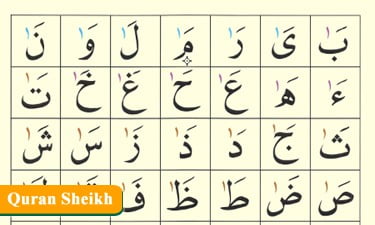
- This lesson is about standing fatha, standing kasrah and standing dummah.
- Standing fatha is equal to alif maddah, standing kasrah is equal to yaa maddah and standing dummah is equal to wao maddah.
- The important point in this lesson is “don’t take the maddah letters which come after noon or meem into the nose”.
Noorani Qaida Lesson 8:

- This lesson is named as Maddoleen.
- In this lesson, students will learn how different maddah letters are pronounced.
- There are three types of Maddah letters:
- Alif Maddah.
- Wao Maddah
- Yaa Maddah
- These letters are soft and long vowel letters.
- These letters are prolonged equal to one alif or one to two seconds.
- In this lesson, the students will also learn about leen letters.
- If the letter before Yaa saakinah and wao saakinah have fatha than alif and wao are called Leen letters.
- An important thing about leen letters is that they are neither prolonged nor read them with a jerk.
Noorani Qaida Lesson 9:
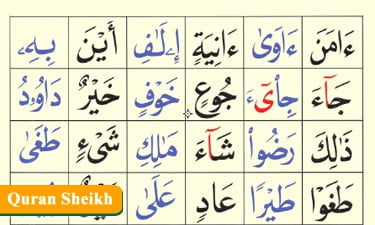
- This lesson is for the exercise of the students.
- Students will exercise of Movements, fateh, kasrah, dummah, Huroof e maddah, etc.
- This lesson will cover the following important rules of Tajweed:
- If there is Hamzah after Maddah, then Maddah will be any of the four kinds
- If Hamzah is in the same word then maddah will be called maddah Mutasil.
- If Hamzah is at the beginning of the next word then maddah will be called madd-e-Munfasil.
- If there is sakoon after a maddah or leen letters the word will be prolonged like madd and is called Madd –e-Lazim.
- If sakoon is due to stop then madd is called madd-e-Arzi.
- All these Madd’s are prolonged from three to five seconds.
- After completing this lesson the students will be able to understand the difficult words to pronounce.
- The students will be able for more complex exercises.

Noorani Qaida Lesson 10:
- This lesson is named as Sakoon or Jazam.
- The students will memorize the name and shape of Jazam.
- After completing this lesson the students will be able to identify the letters with Jazam.
- Students will distinguish between similarly pronounced letters.
- The students will learn how many times that word is read or pronounced.
- Huroof e Qalqalah letters will be discussed in this lesson.
Noorani Qaidah Lesson 11:

- This lesson is for the exercise of sakoon or Jazam.
- Also, the students will learn about more Tajweed rules like.
- When Ikhfaa is done on noon saakinah and Tanween?
- When the Raa letter is bold?
- What are the bold letters?
- Students will learn about the types of stops and when the stop is necessary and when not.
Noorani Qaidah Lesson 12:
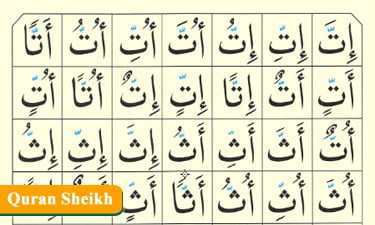
- This lesson is named as Tasdeed.
- The students will learn:
- Rules of Tajweed related to tashdeed.
- Definition of tashdeed and will be able to identify the tashdeed.
- The name of tashdeed letter.
- Moreover, the words having tashdeed sign are pronounced two times by connecting the previous letter.
- These words must be read with a strong voice.
Noorani Qaidah Lesson 13:
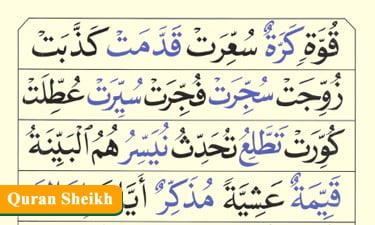
- This lesson is for the exercise of tashdeed.
- Here the students will practice tashdeed with some difficult and complicated words.
- After this lesson student will understand the pronunciation of these words.
- The students will be familiarized with more tashdeed rules.
Noorani Qaidah Lesson 14:
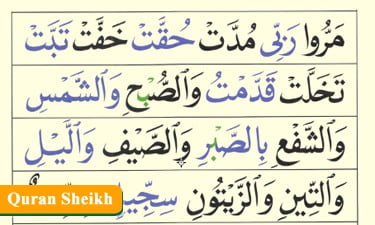
- This lesson is mainly for the exercise of tashdeed with sakoon.
- Most of the rules are covered. Now the lessons are for applying those rules.
Noorani Qaidah Lesson 15:

- This lesson is named as tashdeed with tashdeed which means that two duplication signs.
- Here the students will learn how to pronounce these words.
Noorani Qaidah Lesson 16:

- This lesson is named as tashdeed with Huroof e Maddah.
- In this lesson, the students will learn how to connect the letters with the help of Tajweed rules.
Noorani Qaidah Lesson 17:

- This is the last lesson of this course.
- Here the students will learn rules for noon saakinah and Tanween.
- If noon saakinah and Tanween is followed by Yarmalloon letters then it has some certain rules for pronouncing those words.
- Whenever noon saakinah and Tanween is followed by letter ب then it will be converted into meem and Gunna will be done.
- When meem saakinah is followed by ب or م we will do Gunna on meem saakinah.
Why Quran Sheikh Institute?

The Qur’an is the word of Allah. It’s an honor and blessing for every Muslim parent to witness their children love the Qur’an.
Loving the Qur’an is not only limited to memorizing Quran specific aayaat (verses) when instructed to do so. When a child loves the Qur’an, he feels the urge to recite ayat throughout the day, understand what he’s reciting, and is interested in everything related to the Qur’an.
Children are predominantly influenced by their surroundings and their primary caregivers. So, the role of parents is crucial in helping children develop a strong and loving bond with the Qur’an.
Here are some tips to help you instill the love of Quran in your child’s heart:
- Have your children listen to the Qur’an often.
- Share beautiful stories of the Qur’an with your children.
- Encourage them to share what they’ve learned.
- Go over the meaning of the verses/chapters.
- Take it easy and encourage them.
Read More about Noorani Qaida Course
What is Noorani Qaidah

The first step in learning to read the Quran is to learn, recognize and read out its alphabets. Noorani Qaidah is the basic book to learn these Arabic alphabets. You cannot recite the Holy Quran properly without learning the Noorani Qaidah first.
If you have a strong command of this Qaida, then the Quran recitation will be easy for you. You can say that this is the building block for learning the recitation of the Holy Quran.
Why learn Noorani Qaidah?
Noorani Qaidah is a basic guide to the rules of pronunciation for reciting the Holy Quran. It is a noted fact that people who learn the Noorani Qaidah before starting to learn the recitation of the Holy Quran, they can recite the Holy Quran with more fluent and in a good manner.
As the Arabic language is very difficult for the people with different linguistic background, it is very important that before reciting the Holy Quran they must familiarize with the basic rules of pronunciation of Arabic words and the best way to do that is to learn the Noorani Qaidah.
What will you study?
The Noorani Qaida course is designed for people of every age. It is easily understandable for kids or for aged people. In this course, you will study about the very basic rules of Tajweed. Without knowing these rules you cannot recite the Holy Quran in a proper way.
This course has very easy lessons for learning the Tajweed rules. On completing this course you will be able to recite the Holy Quran fluently.
How to learn Noorani Qaida?

Noorani Qaida is the basic book for learning Arabic pronunciation. This book contains almost 17 different lessons. In the first few lessons, the students are familiarized with Arabic alphabets and then there are lessons by which the students learn the basic Tajweed rules.
This Noorani Qaidah is very easy to learn and it is necessary for all those who want to learn the Holy Quran. Try to learn it step by step and give proper time to it. First, learn daily one lesson and go on increasing your time and lessons. Once you learn it you will find that Quran recitation & Quran memorization will be become too much easy.
Noorani Qaida Online:
Advancements in technology and the web have led to the rising trend of online Quran learning. Now you can take Noorani Qaida lessons directly from your desktop or laptop. It will be like taking regular classes but with a personal tutor. Your kids can benefit a great deal from this systematic and cost-effective study program.
Our Quran website classes is also playing its role to help the Muslims from anywhere or any time in the world. This institute facilitates the Muslims to learn Noorani Qaida online.
Benefits of Qaida Course:
Noorani Qaida contains the Arabic alphabet. A non-Arab person needs to learn the alphabet of the Arabic language before he learns the Holy Quran. Norani Qaidah is beneficial for all those who are not the native Arabs as they cannot pronounce the Qur’anic words until they learn the basic rules about how to pronounce the Arabic alphabets.
Norani Qaida teaches the beginners accurate pronunciation of Arabic words. You are a Muslim, and you want to know about the teaching of Islam; you are supposed to recite the Quran. And you cannot recite the Quran until you learn the Noorani Qaida.
After learning this Qaida course you will be able to recite the Arabic alphabet in a Tajweed accent. With the help of this course, the students will have a good Quran reading foundation.
Noorani Qaida course outline:

Following is the brief course outline:
- Arabic Alphabet & their Proper Pronunciation
- Letter Recognition
- Letter Positions
- Connecting Letters
- Short Vowels (Harakat)
- Long Vowels (Huroof Maddah)
- Sukoon
- Tanween
- Letters of Leen
- Rules of Noon Sakinah & Tanween
- Rules of Raa
- Rules of Laam
- Noon Qutni
- Waqf ( Proper Pausing and Stopping).
Noorani Qaida online course covers:
- Know about the Arabic alphabet.
- Learning of these alphabets with proper pronunciation and in a Tajweed accent.
- Once someone completes this Qaida, he/she can read the Quran fluently depending on the pace that has been developed during this course.
- This course includes topics like Arabic letters, joining letters, lower and upper case, using vowels, silent letters, and punctuation, etc.
- This course ends up with words and verse-making techniques.
Download Noorani Qaida Book PDF:
Noorani Qaida Lesson 1

- This lesson is known as Huroof e Mufridaat (Individual letters).
- This chapter consists of 29 Arabic alphabets from which 7 letters are pronounced with a full mouth (deeply) and only four letters are pronounced from lips.
- Students will know about individual letters in this lesson.
- Familiarization of Arabic alphabet.
- Alphabets are the building blocks so they need special attention.
- Focus on the child’s pronunciation and identification of Dots on different letters.
- Students must be trained to read this lesson from anywhere (i.e. top to bottom and bottom to top).
- Must have a strong practice in bold and light letters.
- If these lessons are not taught properly both the student and teacher will be in trouble in later lessons.
Noorani Qaida Lesson 2:

- This lesson is known as Murakkabat (joint letters)
- When two or more letters are joined together they form a murakkab.
- In this lesson, the students will learn how the words are formed by joining the alphabets.
- The students will be able to identify every alphabet in a word e.g.لا is actually formed by combining ل + ا.
- The students will also learn the different shapes of particular letters.
- One thing is important that the student will read each letter separately during reading these words.
- Make sure to pronounce the words in Arabic tone and accent.
- Most of the letters are identical in shape and in compound form can be identified by the positions and number of dots.
Noorani Qaida Lesson 3:

- This lesson is about Huroof e Muqataat.
- These Huroof mainly occurs at the start of Surahs of the Holy Quran.
- There are certain rules for this lesson.
- Read these letters separately, stretch them according to the defined length, and also perform Ghunnah when Ikhfa and Idghaam occur.
- There are 2 ways to read these letters”
- Wasl (by joining with the next letter).
- Waqf (read one of these letters, stop and read the next letter).
Noorani Qaida Lesson 4:

- The fourth lesson is about Harakat (Movements).
- In this lesson, the students will learn about the three types of Harakat. I.e. zabar (fatha),zer (kasrah),paish (dummah).
- Zabar is always above the letter, zer is always below the letter, paish is always above the letter and paish is always above the letter.
- Students will learn these movements’ symbols and their pronunciation.
- The point to be noted in this lesson is that neither prolongs the letter which has fatha, kasrah or dummah nor read it with a jerk.
Noorani Qaida Lesson 5:

- This lesson is named as Tanween.
- Double fatha, double kasrah, and double dummah are called Tanween. And the letters which have Tanween are called munawwan.
- Before this lesson, the students are already well aware of the identification of letters. Here they will learn proper sounds and pronunciations of these symbols and signs.
- Actually, Tanween is nothing but a noon saakinah which appears at the end of the words.
- In this lesson, the students will practice to do ikhfa. Hiding the voice of meem or noon partially in the nose is called Ikhfa.
- Whenever Tanween is followed by throaty letters then don’t do ikhfa.
- In this lesson the students will learn about the rule of Tanween; that is after Tanween if ا or ی occurs, they become silent.
Noorani Qaida Lesson 6:

- This lesson is about Tanween and movements; how they are combined.
- The students will learn how to connect different letters in accordance with Tajweed rules and must practice.
- This lesson provides an opportunity for students to make exercise of movements and Tanween.
- The most important rule of Tajweed will be discussed in this lesson.
- Before going through this lesson students must revise the previous lessons.
- Most of the students find difficulty in connecting the letters but if they practice it for some time they become familiar with the connectivity of letters.
Noorani Qaida Lesson 7:

- This lesson is about standing fatha, standing kasrah and standing dummah.
- Standing fatha is equal to alif maddah, standing kasrah is equal to yaa maddah and standing dummah is equal to wao maddah.
- The important point in this lesson is “don’t take the maddah letters which come after noon or meem into the nose”.
Noorani Qaida Lesson 8:

- This lesson is named as Maddoleen.
- In this lesson, students will learn how different maddah letters are pronounced.
- There are three types of Maddah letters:
- Alif Maddah.
- Wao Maddah
- Yaa Maddah
- These letters are soft and long vowel letters.
- These letters are prolonged equal to one alif or one to two seconds.
- In this lesson, the students will also learn about leen letters.
- If the letter before Yaa saakinah and wao saakinah have fatha than alif and wao are called Leen letters.
- An important thing about leen letters is that they are neither prolonged nor read them with a jerk.
Noorani Qaida Lesson 9:

- This lesson is for the exercise of the students.
- Students will exercise of Movements, fateh, kasrah, dummah, Huroof e maddah, etc.
- This lesson will cover the following important rules of Tajweed:
- If there is Hamzah after Maddah, then Maddah will be any of the four kinds
- If Hamzah is in the same word then maddah will be called maddah Mutasil.
- If Hamzah is at the beginning of the next word then maddah will be called madd-e-Munfasil.
- If there is sakoon after a maddah or leen letters the word will be prolonged like madd and is called Madd –e-Lazim.
- If sakoon is due to stop then madd is called madd-e-Arzi.
- All these Madd’s are prolonged from three to five seconds.
- After completing this lesson the students will be able to understand the difficult words to pronounce.
- The students will be able for more complex exercises.

Noorani Qaida Lesson 10:
- This lesson is named as Sakoon or Jazam.
- The students will memorize the name and shape of Jazam.
- After completing this lesson the students will be able to identify the letters with Jazam.
- Students will distinguish between similarly pronounced letters.
- The students will learn how many times that word is read or pronounced.
- Huroof e Qalqalah letters will be discussed in this lesson.
Noorani Qaidah Lesson 11:

- This lesson is for the exercise of sakoon or Jazam.
- Also, the students will learn about more Tajweed rules like.
- When Ikhfaa is done on noon saakinah and Tanween?
- When the Raa letter is bold?
- What are the bold letters?
- Students will learn about the types of stops and when the stop is necessary and when not.
Noorani Qaidah Lesson 12:

- This lesson is named as Tasdeed.
- The students will learn:
- Rules of Tajweed related to tashdeed.
- Definition of tashdeed and will be able to identify the tashdeed.
- The name of tashdeed letter.
- Moreover, the words having tashdeed sign are pronounced two times by connecting the previous letter.
- These words must be read with a strong voice.
Noorani Qaidah Lesson 13:

- This lesson is for the exercise of tashdeed.
- Here the students will practice tashdeed with some difficult and complicated words.
- After this lesson student will understand the pronunciation of these words.
- The students will be familiarized with more tashdeed rules.
Noorani Qaidah Lesson 14:

- This lesson is mainly for the exercise of tashdeed with sakoon.
- Most of the rules are covered. Now the lessons are for applying those rules.
Noorani Qaidah Lesson 15:

- This lesson is named as tashdeed with tashdeed which means that two duplication signs.
- Here the students will learn how to pronounce these words.
Noorani Qaidah Lesson 16:

- This lesson is named as tashdeed with Huroof e Maddah.
- In this lesson, the students will learn how to connect the letters with the help of Tajweed rules.
Noorani Qaidah Lesson 17:

- This is the last lesson of this course.
- Here the students will learn rules for noon saakinah and Tanween.
- If noon saakinah and Tanween is followed by Yarmalloon letters then it has some certain rules for pronouncing those words.
- Whenever noon saakinah and Tanween is followed by letter ب then it will be converted into meem and Gunna will be done.
- When meem saakinah is followed by ب or م we will do Gunna on meem saakinah.
We Always Hear Your Questions (FAQs)
You should learn Noorani Qaida because it will help you to read and recite the Quran correctly and fluently. Noorani Qaida teaches you the basics of the Arabic alphabet, the rules of Tajweed, and the pronunciation of Quranic words. Some of the benefits of learning Noorani Qaida are:
✅ It helps you to develop your reading skills and improve your comprehension of the Quran.
✅ It increases your understanding of the Quran and its teachings.
✅ It provides you with a strong foundation for your future religious studies and learning.
✅ It enables you to recite the Quran with accuracy and confidence.
✅ It brings you closer to Allah and His mercy.
The Noorani Qaida Course is considered essential pre-course comprehensive courses to learn Quran Recitation with Tajweed smoothly.
There are 17 lessons in Noorani Qaida book.
By learning these lessons, you will be able to read and recite the Quran correctly and fluently with Tajweed rules.
The writer of Noorani Qaida is Sheikh Noor Mohammed Haqqani, an Indian scholar who compiled the book to teach the basics of Arabic and Quranic recitation.
The Noorani Qaida course takes about 3 ~ 6 months to complete. However, this may vary depending on the student’s ability and interest. The course is designed to teach the basics of the Arabic language and the Quran with proper Tajweed rules. It is suitable for kids and beginners who want to learn how to read the Quran fluently and correctly.
It is Online Course, Book free trial now.
Best Noorani Qaida Course, Learn Quranic Arabic online 30% OFF | QuranSheikh
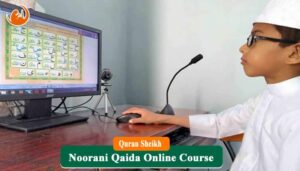
Noorani Qaida is the most efficient curriculum specially planned for non Arab muslim kids & beginner adults to learn Quran reading usa, uk, australia
Course Provider: Organization
Course Provider Name: QuranSheikh
Course Provider URL: www.quransheikh.com
5
